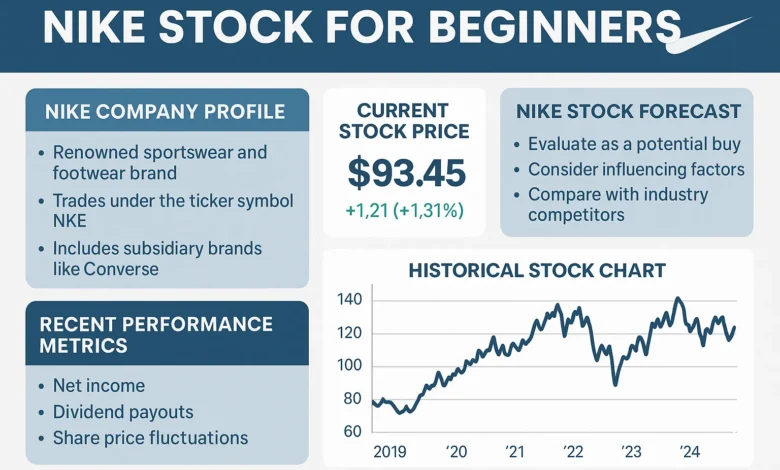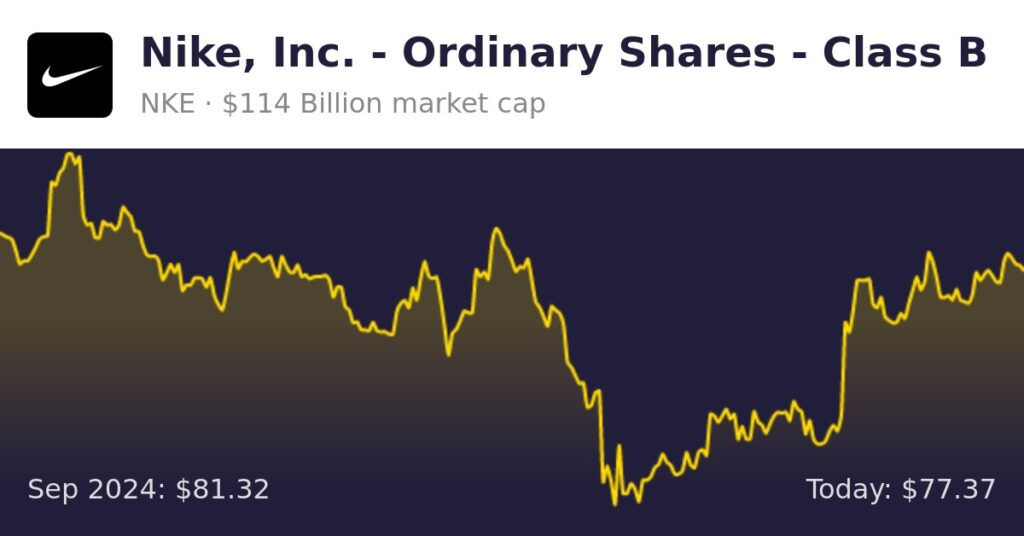Nike Stock Dividend: A Deep Dive into the Swoosh’s Payout for Investors

When you think of Nike Stock Dividend images of elite athletes, iconic “Just Do It” campaigns, and innovative sneakers likely come to mind. It’s a global powerhouse in athletic apparel and footwear, a brand synonymous with performance and style. But for the savvy investor, Nike represents another compelling opportunity: a long-standing and growing dividend stock.
While Nike will never be confused with ultra-high-yield “income” stocks, its dividend is a critical component of its total return story. It’s a testament to the company’s mature profitability, robust financial health, and commitment to returning value to shareholders. This in-depth guide will explore everything you need to know about the Nike stock dividend, from its history and current yield to the financial engine that powers it and what it means for your portfolio. We’ll analyze its status as a Dividend Aristocrat, compare it to competitors, and provide a clear strategy for investors considering NKE for its income-generating potential.
Nike’s Dividend Profile: The Key Numbers (2024)
First, let’s ground our discussion with the essential facts and figures that define Nike’s dividend as of its latest declarations. Understanding these metrics is crucial for any fundamental analysis.
- Current Dividend Yield: Typically fluctuates between 1.0% and 1.5%. This is lower than the average yield of the S&P 500, which often hovers around 1.6%, placing it in the category of a “low-yield” stock. The yield is dynamic and changes inversely with the stock price.
- Dividend Payout: Nike pays a quarterly cash dividend. The most recent increase, announced in November 2023, set the quarterly dividend at $0.37 per share.
- Annual Dividend: With four quarterly payments, the current annual dividend stands at $1.48 per share.
- Payment Schedule: Nike follows a standard quarterly schedule, typically paying dividends with a declaration in late November for shareholders of record in early December, with payments made in early January. The cycle continues with payments in April, July, and October.
- Payout Ratio: Nike maintains a very conservative payout ratio (the percentage of earnings paid out as dividends), often sitting between 30-40%. This low ratio is a profound sign of strength, indicating that the dividend is highly secure and that the company retains ample earnings—often billions of dollars—to reinvest in growth initiatives like marketing, innovation, and its direct-to-consumer channel without jeopardizing the payout.
A History of Consistent Growth: The Prestigious Dividend Aristocrat Status

The most compelling aspect of Nike Stock Dividend isn’t its current yield, but its remarkable consistency and growth. In 2021, Nike achieved a prestigious milestone in the investing world: it was officially added to the S&P 500 Dividend Aristocrats Index.
What is a Dividend Aristocrat?
This is an exclusive club consisting of S&P 500 companies that have not only paid but also increased their base dividend for at least 25 consecutive years. Nike’s inclusion signals a profound commitment to shareholder returns and a demonstrated ability to generate growing profits through various economic cycles, including the Dot-Com bust, the 2008 Financial Crisis, and the COVID-19 pandemic. This track record builds immense investor confidence, as it demonstrates financial discipline and a shareholder-friendly culture at the highest level.
Nike’s dividend growth rate over the past decade has been impressive, often averaging in the low double digits on a percentage basis. For example, the quarterly dividend has increased from:
- $0.12 per share in 2014
- $0.22 per share in 2018
- $0.275 per share in 2021
- To the current $0.37 per share in 2024
This represents a significant jump that compounds wealth for long-term holders. An investor who bought shares a decade ago now enjoys a yield on cost (the annual dividend divided by their original purchase price) that is substantially higher than the current stated yield, showcasing the power of dividend growth investing.
The Financial Engine: Why Nike Can Afford a Growing Dividend
A dividend is only as strong as the company behind it. Nike’s ability to consistently raise its payout is directly fueled by its powerful, cash-generating business model and stellar financial performance. Several key pillars support this.
- Unmatched Brand Dominance and Pricing Power: Nike’s brand is its most valuable asset, consistently ranked as one of the most valuable in the world. This immense brand equity allows it to command premium prices for its products, resulting in strong gross margins that typically exceed 44%. Consumers aren’t just buying sneakers or apparel; they’re buying into an identity, a story, and a promise of performance, and they’re willing to pay a premium for it. This pricing power insulates margins and ensures profitability.
- The Strategic Direct-to-Consumer (DTC) Revolution: A key strategic shift has been the aggressive pivot to Nike Direct, which includes its own retail stores (Nike Live, Nike House of Innovation) and its incredibly successful digital channels (the Nike app and Nike.com). This DTC model is highly lucrative because it:
- Increases Profit Margins: By cutting out the wholesale middleman, Nike captures the full profit on each sale.
- Provides Invaluable Data: It grants Nike first-party data on consumer behavior, preferences, and buying patterns, allowing for hyper-targeted marketing and product development.
- Strengthens Brand Connection: It creates a direct, personalized relationship with consumers.
This higher-margin revenue directly boosts the free cash flow that funds dividends and share buybacks.
- Innovation as a Core Driver: Continuous investment in research and development leads to groundbreaking products and technologies like Air Max, Dri-FIT, Vaporfly, and, more recently, Nike Adapt and sustainable initiatives like Nike Forward. Innovation creates demand, drives full-price sales, and protects market share against fierce competitors like Adidas, Puma, and Lululemon. It ensures the product pipeline remains fresh and exciting.
- Strong Cash Flow Generation: Ultimately, dividends are paid with cash, and Nike is a cash flow machine. The company consistently generates several billion dollars in annual free cash flow (FCF). For example, in its Fiscal Year 2023, Nike generated over $3.7 billion in Free Cash Flow. This massive and consistent cash pile ensures the dividend is not only safe but has ample room to grow, even as the company continues to invest heavily in its future.
- A Rock-Solid Balance Sheet: Nike maintains a very healthy balance sheet with significant cash reserves and manageable debt levels. This financial fortress provides flexibility to navigate economic downturns, make strategic acquisitions, and continue returning capital to shareholders through thick and thin.
Nike Dividend vs. Growth: A Balanced Investment Proposition
It’s crucial to understand Nike’s identity in a portfolio. It is not an income stock designed to provide substantial quarterly cash flow for retirees. Instead, it is a quintessential growth-and-income or quality compounder stock.
- Primary Driver: Capital Appreciation. The majority of an investor’s return from Nike over the long term is expected to come from the growth in its stock price, driven by increasing global sales, expanding margins, and rising earnings per share (EPS).
- Secondary Driver: The Dividend. The dividend serves as a steady, growing cash return that rewards patience and compounds over time. It provides a cushion during market downturns and significantly enhances the total return. For long-term investors, the growth of the dividend itself can become a major source of returns.
For investors, this means focusing on total return (share price appreciation + dividends) rather than just the yield. A company growing its dividend at 10% annually will see its effective yield on the original cost basis climb dramatically over a decade, a concept central to dividend growth investing strategies.
Nike vs. Competitors: A Dividend Comparison
How does Nike stack up against its main rivals in the dividend department?
- Adidas (ADDYY): Adidas also pays a dividend but does not have a track record of consistent annual increases like Nike. Its yield is often similar or slightly higher, but it lacks the Dividend Aristocrat status, making its payout less predictable.
- Lululemon (LULU): Lululemon is a high-growth company but does not currently pay a dividend. It reinvests all its profits back into the business to fuel expansion. This makes Nike a more attractive option for investors seeking any form of current income.
- Under Armour (UAA): Under Armour has struggled with profitability and does not pay a dividend. It suspended its modest program in 2017 to conserve cash.
This comparison highlights Nike’s unique position as a mature, profitable company in its sector that is committed to returning capital to shareholders, setting it apart from both struggling players and newer, high-growth competitors.
Risks and Considerations for the Dividend Investor
No investment is without risk, and Nike’s dividend story has its own set of considerations.
- Low Starting Yield: For investors seeking immediate income to live on, a ~1.3% yield is likely insufficient on its own. It should be part of a diversified income portfolio.
- Economic Sensitivity: As a consumer discretionary company, Nike’s sales can be sensitive to economic recessions. If consumers cut back on spending, Nike’s earnings and cash flow could temporarily dip, potentially slowing the pace of dividend growth (though a cut is considered highly unlikely due to its strong balance sheet).
- Intense Competition and Market Saturation: The athleticwear market is fiercely competitive and subject to changing consumer tastes. Nike must continually innovate and market effectively to maintain its edge. Any missteps could impact long-term growth prospects and, by extension, dividend growth.
- Global Supply Chain and FX Risk: As a global company, Nike is exposed to currency fluctuations (FOREX), which can impact reported earnings when converting overseas revenue back to U.S. dollars. It also manages a complex global supply chain, which can be disrupted by geopolitical events, trade wars, or pandemics, as seen during COVID-19.
How to Invest in Nike for the Dividend
Investing in Nike stock is a straightforward process:
- Open a Brokerage Account: Choose an online broker that aligns with your investment needs (e.g., Fidelity, Charles Schwab, Vanguard, E*TRADE).
- Fund Your Account: Transfer money into your brokerage account.
- Purchase Nike Stock: Search for the ticker symbol NKE and place an order to buy shares.
- Hold Through the Ex-Dividend Date: To be eligible for a dividend, you must own the stock before the ex-dividend date. If you buy on or after this date, you will not receive the upcoming payment. The record date is set after the ex-dividend date to determine the official list of shareholders.
- Collect Dividends: The cash will automatically be deposited into your brokerage account on the designated payment date.
Many brokers also offer DRIP (Dividend Reinvestment Plans), which allow you to automatically use your dividend cash to purchase more fractional shares of Nike. This is a powerful tool for accelerating the power of compounding without incurring trading commissions.
Final Verdict: Is Nike a Good Dividend Stock?
Yes, but with a specific purpose and understanding.
The Nike stock dividend is a hallmark of a mature, financially exceptional company that confidently rewards its shareholders. It is the definition of a quality dividend growth stock.
You should consider Nike for your portfolio if:
- You are a long-term investor focused on total return.
- You appreciate the stability and prestige of a Dividend Aristocrat with a proven track record.
- You want exposure to a powerful, globally recognized brand with a proven growth trajectory.
- You believe in the compounding power of a dividend that grows significantly faster than the rate of inflation.
You might look elsewhere if:
- You are a retiree or an investor who requires a high current yield for immediate income needs.
- You are seeking a pure, high-yield income stock from sectors like utilities or REITs.
Conclusion
while the Nike dividend won’t make you rich from income alone, it represents a critical piece of a world-class equity story. It’s a signal of financial strength, a reward for shareholder loyalty, and a key ingredient in the long-term wealth-building potential of owning a share of the Swoosh. For the patient investor, the combination of brand power, global growth, and a reliably increasing dividend makes Nike a compelling holding for a diversified portfolio.
